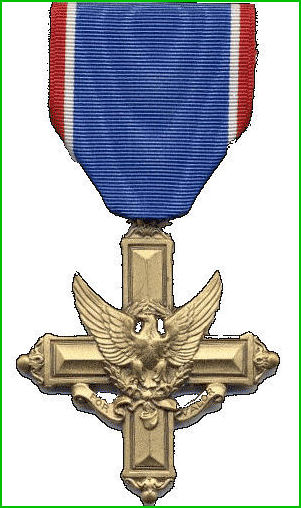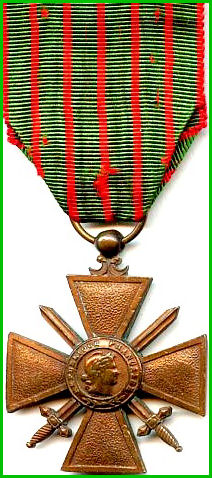





Walter Richard Flannery was born in Pittsburgh, Pennsylvania, on 22nd March 1891; the son of James J. and Harriet Flannery (née Rogers), with brothers John R., James J. Jr., Howard J., Raymond, and Eugene G., and sisters Harriet E., Evelyn F., and Edna E.
At the time of his draft, he was employed as an electric furnace melter for the American Vanadium Company in Bridgeville, PA, and was described as tall and stout with grey eyes and black hair.
Walter first came to prominence when he was awarded the Distinguished Service Cross in 1918. The official citation for this prestigious military decoration reads as follows:-
The President of the United States of America, authorized by Act of Congress, July 9, 1918, takes pleasure in presenting the Distinguished Service Cross to First Lieutenant (Infantry) Walter R. Flannery, United States Army, for extraordinary heroism in action while serving with 70th Infantry Regiment, 3rd Division, A.E.F., near Sauvigny, France, 3 June 1918. At great peril to his life on the night of June, 1918, First Lieutenant Flannery voluntarily swam the River Marne, near Sauvigny, France, and brought back a wounded French soldier, who, having escaped from his German captors, was unable to return to his own lines. - War Department, General Orders No. 99 (1918)
His act of heroism also earned him the French War Cross (“Croix de Guerre”), and he was the first American soldier to receive it.
One newspaper report included an interview with Walter where he is keen to play down the significance of his award-winning conduct. The event is retold in his own words, and provides an interesting insight into the man behind the medals, as follows:-
HERO BELITTLES DEED
——–
Doesn’t Think Much of Act That Won Cross
——–
All He Did Was Swim River Under Fire and Rescue Wounded Frenchman.
——–
Pittsburgh. - “Now listen, get me! There’s been so much hot air about this hero stuff that I want you to get it straight. I saw this French bird
across the river and I went and got him. If I hadn’t someone else probably would have taken the same chance.”
In these words Capt. Walter R. Flannery, who was awarded the Cross of War for swimming the Marne river and rescuing a wounded French soldier
at the time the Germans held the Aisne-Marne salient, disposes of any attempt to make a hero of him for the deed. At the time Flannery was
a lieutenant. He is at his home here on furlough.
The wounded man lay on the bank across the river from where the Americans were stationed at Savigny. Disregarding a French officer’s warning
that it was probably a ruse to attract Americans over that the Huns might learn what division opposed them, Flannery waited until nightfall,
when he stripped to his underclothing and swam across. The Germans spotted him and most of the trip was under water. Flannery tells the rest
of the story as follows:
“When I got over I found the man. All the French I knew was ‘ici, ici’ - ‘here, here’ - and then the bird went hysterical and refused to come
into the water. He was too weak to tie the rope I had brought along, so I had to drag him in. We got over all right.
“But the joke was that a couple of days later I got orders to report to a French colonel. Headquarters was about seven miles away, so I hoofed
it back, expected to be put on patrol duty of some sort. I presented myself and couldn’t find out that the program was. They told me to go
stand behind a major. I did, but the major kept rambling around, and me after him like a goof.
“Then I was told to go forward on the parade ground, and a French general lined me up, pointed a sword at me and turned on the French. It wasn’t
much of a conversation, for I didn’t know what he was talking about, so I just grinned. Then he let down the sword, pinned this on me - the Croix
de Guerre - and started kissing me. Say, that mustache tickled me from ear to ear. I’m off saving men after this.”
But his attempts to deflect attention were not successful. Since he was a steelworker back home in Pittsburgh, his image was incorporated into an industrial safety poster warning steel workers of the perils of splashed molten steel and cautioning them to wear safety goggles.
To further compound the publicity of his deeds, his portrait in military uniform was painted by Henry Salem Hubbell. The oil painting was put on display at the Smithsonian Institution in Washington D.C. alongside similar portraits of other war heroes.
The painting still forms part of the collection of the Institution’s National Museum of American History, Division of Armed Forces History. It is not currently on view due to building maintenance but the Smithsonian Institution have kindly sent us an inventory image which is reproduced above. The portrait shows the Distinguished Service Cross on the left, and the Croix de Guerre (with ribbon augmented by a star and two palm leaves to denote the high level of his citation in dispatches) on the right. It is evident that Walter was promoted from first lieutenant to captain as a result of his heroic act.
[his portrait is illustrated above; painted by Henry Salem Hubbell, courtesy of the Smithsonian Institution]